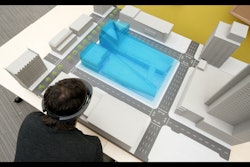
The purpose of the Work In Progress (WIP) report is to determine whether you are over-billed or under-billed on the jobs under way. This is an important piece of information to know. Your bank account looks good when most of the jobs are about halfway to completion. Your profitability falls apart when several of the jobs simultaneously near completion. Projects often run out of billing while they near punch list. Not knowing where you stand on your billing versus your actual progress creates cash flow and profitability.
Construction tax accounting is supposed to have line items on both the balance sheet and the income statement for over/under billings. The value on that line is determined by a WIP report. The over/under billing result from the WIP shows up in the revenue area of your income statement. If you are under-billed it will show up as additional revenue. If you are over-billed it will show up as negative revenue. On the balance sheet, over-billing is a short-term liability and under-billing is a short-term asset.
There are three primary contributors to contractors being caught off guard by cost overruns.
- Failure to monitor field progress accurately
- Aggressive up-front billing
- Failure to maintain an accurate WIP report
The second factor is not a problem if the first and third are adequately handled. Contractors tend to be very aggressive in their billing. For example, when I reviewed pay applications while working as the general manager of a commercial general contractor the first line item I looked for was the amount of money the subcontractor was trying to get for mobilization. Inevitably the requests were outlandish. It was our subcontractors' attempt to expedite cash flow.
An aggressive billing strategy makes sense to offset the pay delays of 45 to 75 days. The problem occurs when the aggressive billing throws off your understanding of how you are doing on the job. WIP reports filled out correctly solve that problem.
WIP reports can be surprisingly easy to set up and maintain. If your accounting system has the feature all you need to do is update the percent-complete entry on each project weekly. The system should take care of the calculations and will have a preformatted report you can run.
If you don't have the WIP feature in your accounting system you should use Excel for your WIP. If you have the WIP feature in your accounting system use it. The system will produce a more proper income statement and balance sheet than if you use Excel.
If you are running QuickBooks and haven't purchased the Enterprise version you will not find the WIP feature. The Contractor Premier version does not include it.
Moving on to the mechanics of the WIP, the single most important line item is the percent-complete entry. Every other entry will be based on your costs to date, your budget and your contract. The WIP multiplies percent complete against total contract value to determine earned revenue. If your billed revenue exceeds your earned revenue you will be over-billed. If your earned revenue exceeds your billed revenue then you are under-billed.
Over-billed leads to running out of billable money prior to your costs-to-complete ending. The reverse is true for under-billing.
Let's move on to determining your percent complete. For a trade that is mostly labor the decision functionally should come down to how much of the work the field has completed. This should not be based on hours used or labor dollars spent. That is a common default built into accounting systems and is the worst method for determining percent complete.
Basing the number on hours used or labor cost versus the budget divorces you from reality. That approach makes your progress look like it is fine until you run out of hours and budget. Then you go over without foresight into how big your loss will be. By basing your percent complete on the amount of work completed versus the amount of work left to complete you will get much earlier warning when the job is slipping and in danger of going over budget. The WIP report will show you where your costs are likely to end up at the completion of the project long before that future is locked in, potentially saving you tens of thousands of dollars.
If material cost represents a heavy cut of your costs the determination of percent complete gets a bit more complicated. You will probably be buying quite a chunk of your materials before your crews need them. You should bill for those materials immediately and reflect that cost in your percent complete as they comprise a considerable part of your job budget. In this case I recommend using a two-factor percent-complete calculation.
Determine how much of your budget is taken up by material cost. That is the weighting you should use for the material cost contribution to percent complete. For example, if material is 40 percent of your budget and you have bought half of the material, the material contribution to your completion percentage is 50% of 40% — or 20% overall.
If your field crews are roughly 10% done with their work, their contribution to the projection is 10% of 60%, or 6%. Add the two results together to arrive at a percent complete projection of 26%. This is a bit more complicated, but it reveals a much truer financial picture than any other approach I can think of.
If you have projects that frequently run over four weeks in length you certainly should create and maintain a WIP report. If not then don't sweat it. If at year end you rarely have a job of size carrying over into the new year don't sweat it. The WIP report is only needed when sizable projects are extending past the closing date of your books.




















